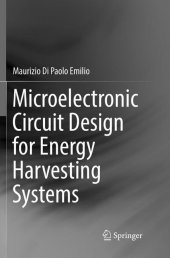 Neuerscheinungen 2018Stand: 2020-02-01 |
Schnellsuche
ISBN/Stichwort/Autor
|
Herderstra▀e 10
10625 Berlin
Tel.: 030 315 714 16
Fax 030 315 714 14
info@buchspektrum.de |

Maurizio Di Paolo Emilio
Microelectronic Circuit Design for Energy Harvesting Systems
Softcover reprint of the original 1st ed. 2017. 2018. xxii, 169 S. 100 SW-Abb., 33 Farbabb., 100 Farbta
Verlag/Jahr: SPRINGER, BERLIN; SPRINGER INTERNATIONAL PUBLISHING 2018
ISBN: 3-319-83775-3 (3319837753)
Neue ISBN: 978-3-319-83775-8 (9783319837758)
Preis und Lieferzeit: Bitte klicken
This book describes the design of microelectronic circuits for energy harvesting, broadband energy conversion, new methods and technologies for energy conversion. The author also discusses the design of power management circuits and the implementation of voltage regulators. Coverage includes advanced methods in low and high power electronics, as well as principles of micro-scale design based on piezoelectric, electromagnetic and thermoelectric technologies with control and conditioning circuit design.
Introduction 1.1 Fundamentals 1.2 Sensors and Transducers 1.2.1 Temperature sensors 1.2.2 Magnetic field sensors 1.2.3 Potentiometers 1.2.4 Light Detection 1.3 Communications Cabling 1.3.1 Noise 1.4 Parameters 1.4.1 Noise 1.4.2 Settling time 1.4.3 DC input characteristics References The fundamentals of Energy Harvesting 2.1 What┤s Energy? 2.2 Why Energy Harvesting? 2.3 Free Energy 2.4 Power Management Unit 2.5 Storage systems References Input Energy 3.1 Mechanical energy 3.2 Thermal Energy 3.3 Electromagnetic energy 3.4 Space Radiation 3.5 Solar Radiation 3.5.1 Photovoltaic cell References Electromagnetic transducers 4.1 Introduction 4.2 Electromagnetic Waves and Antenna 4.3 System Design References Piezoelectric transducers 5.1 Introduction 5.2 Materials 5.3 Model 5.4 System design References Thermoelectric transducers 6.1 Introduction 6.2 Seebeck and Peltier effect 6.3 Potential 6.4 Charges in a semiconductor with a temperature gradient 6.5 Thermoelectric effect 6.6 Thomson effect 6.7 Thermoelectric generator 6.8 Materials 6.9 Figure of merit References Electrostatic transducers 7.1 Introduction 7.2 Physical phenomena 7.3 Switching system 7.4 Continuos systems 7.5 Design References Powering microsystem 8.1 Power conditioning 8.2 Rectifier circuit 8.2.1 Bridge rectifier circuit 8.2.2 Zener diode as voltage regulator 8.2.3 Considerations 8.3 Piezoelectric biasing 8.4 Voltage Control 8.5 MPPT 8.6 Architecture 8.7 DC-DC systems 8.7.1 Linear regulators 8.7.2 Switching regulators 8.7.3 Buck converter 8.7.4 Boost converter 8.7.5 Buck-boost converter 8.7.6 Armstrong Oscillator 8.8 Load matching 8.9 AC-DC Systems 8.10 Electrical storage buffer 8.10.1 Supercapacitors References Low power circuits 9.1 Introduction 9.2 Review of Microelectronics 9.2.1 Basic of semiconductor┤s physics 9.2.2 PN Junction 9.2.3 Diode 9.2.4 Bipolar Transistor: Emitter Follower 9.2.5 MOS Transistor 9.2.6 Differential Amplifiers 9.2.7 Feedback 9.2.8 Effects of feedback 9.2.9 Digital CMOS Circuits 9.2.10 CMOS Inverter 9.2.11 Current Mirror 9.2.12 Ideal Current Mirror 9.2.13 Current Mirror BJT/MOS 9.3 Low power MOSFET 9.3.1 General characteristics of a MOSFET 9.3.2 Mosfet Power Control 9.3.3 Stage of Amplification 9.3.4 Common Source 9.4 Analog Circuits 9.5 Operational Amplifier 9.6 Power supply and rejection 9.7 Low noise pre-amplifiers References Low-power solutions for biomedical / mobile devices 10.1 Introduction 10.2 Design of Wearable devices 10.3 RF Solutions for Mobile 10.3.1 Ferrite rod antenna 10.3.2 Circular spiral inductor antenna 10.3.3 Folded dipole 10.3.4 Microstrip Antenna 10.4 Power management 10.5 Ultra-low Power 2.4GHz RF Energy Harvesting and Storage System References Applications of Energy Harvesting 11.1 Introduction 11.2 Building Automation 11.3 Environmental monitoring 11.4 Structural Health monitoring 11.5 Automotive 11.6 Projects 11.7 Solar Infrastructure 11.8 Wind energy 11.9 Conclusions References Index
Maurizio Di Paolo Emilio is a Ph.D. in Physics and a Telecommunication Engineer. He has worked on various international projects in the field of gravitational wave research. Working as a software/hardware developer in the data acquisition system, he participated as the designer of the thermal compensation system (TCS) for the optical system used in the Virgo Experiment (an experiment for detection of the gravitational wave). Actually, He works as Technical writer and electronic designer in the X-ray field to design new devices about High Voltage systems and Microbeam for radiobiological and microscopy applications. Di Paolo Emilio is also the author of numerous publications on electronics design, data acquisition system, PCB, IT and embedded system.


